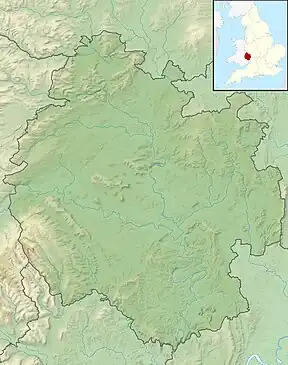| Wigmore Abbey Grange | |
|---|---|
.jpg.webp) The entrance gatehouses to the Grange | |
| Type | Monastic grange |
| Location | Adforton, Herefordshire |
| Coordinates | 52°20′11″N 2°52′00″W / 52.3364°N 2.8667°W |
| Built | 12-14th centuries with later additions |
Listed Building – Grade I | |
| Official name | The Grange, Adforton |
| Designated | 11 June 1959 |
| Reference no. | 1082057 |
Listed Building – Grade I | |
| Official name | Gatehouse Attached to West End of the Grange |
| Designated | 11 June 1959 |
| Reference no. | 1349753 |
Listed Building – Grade I | |
| Official name | Outbuilding About 95 Yards West-North-West of the Grange |
| Designated | 11 June 1959 |
| Reference no. | 1082061 |
Listed Building – Grade I | |
| Official name | Storage Building About 100 Yards West-North-West of the Grange |
| Designated | 11 June 1959 |
| Reference no. | 1179912 |
Listed Building – Grade II | |
| Official name | Summerhouse About 50 Yards South-East of the Grange |
| Designated | 19 February 1987 |
| Reference no. | 1082059 |
 Location of Wigmore Abbey Grange in Herefordshire | |
Wigmore Abbey Grange is a complex of former monastic buildings just north of the village of Adforton, Herefordshire, England.
History
Wigmore Abbey was founded by Hugh de Mortimer and was first established at Shobdon in 1135, moving to Wigmore in 1160 and finally to Adforton in 1172.[1] Much of the abbey was destroyed in a Welsh uprising in 1221,[2] but was rebuilt by Edmund Mortimer in the 1370s.[3] Very little of the rebuilt abbey now remains, beyond some stretches of wall.[1] In the Middle Ages the abbey developed into the largest in Herefordshire and built a farm, called a monastic grange, to supply provisions.[3]
The Grange at Wigmore comprises a complex of structures dating from the 12th and the 14th centuries.[4] The main building, The Grange, was developed from the abbot's lodgings and subsequently became the grange farmhouse.[1]
In the mid-18th century, a family called Galliers were resident at the Grange and established a notable herd of Hereford cattle.[5] The actor John Challis owned the Grange from 1998 until his death in 2021.[6]
The Grange in art
The architect Edward Blore drew the abbot's lodging in 1850.[7] The amateur artist Louisa Puller painted a similar view in a watercolour of 1941, as part of her work for the Recording Britain project.[8] The artist John Piper painted the lodging in the 1950s.[9]
Architecture and description
The Grange is an L-shaped building, now of three storeys, although originally of two. The sub-structure is Norman, including the undercroft, but much of the upper part of the building is restoration work of the 16th, 17th and 20th centuries.[1] The inner, and two outer, gatehouses are 14th century, while the range ends in an 18th century summer house.[1] The Grange is a Grade I listed building.[4] The gatehouse,[10] and two outbuildings share this, the highest, listing designation,[11][12] while a barn,[13] gardens walls and a mounting block,[14] and the summerhouse are listed Grade II.[15]
Notes
References
- 1 2 3 4 5 Brooks & Pevsner 2012, pp. 81–82.
- ↑ Brown 2002, p. 3.
- 1 2 "Adforton". British History Online. Retrieved 24 May 2021.
- 1 2 Historic England. "The Grange, Adforton (Grade I) (1082057)". National Heritage List for England.
- ↑ Greene, Miranda. "Hereford Cattle 1700-1900". Hereford Council. Retrieved 24 May 2021.
- ↑ "Interview: John Challis talks moving to Shropshire Star ahead of new book, Wigmore Abbey: The Treasure Of Mortimer, release". Shropshire Star. 24 October 2016.
- ↑ Wright, Colin. "Wigmore Grange". British Library. Retrieved 24 May 2021.
- ↑ "Grange Farm, The Abbot's House, Wigmore Abbey remains". Victoria and Albert Museum. Retrieved 24 May 2021.
- ↑ "John Piper: Wigmore Abbey Gateway, Herefordshire". Fifties Art and Design. Retrieved 24 May 2021.
- ↑ Historic England. "Gatehouse Attached to West End of Wigmore Abbey Grange (Grade I) (1349753)". National Heritage List for England.
- ↑ Historic England. "Outbuilding About 95 Yards West-North-West of Wigmore Abbey Grange (Grade I) (1082061)". National Heritage List for England.
- ↑ Historic England. "Storage Building About 100 Yards West-North-West of Wigmore Abbey Grange (Grade I) (1179912)". National Heritage List for England.
- ↑ Historic England. "Barn About 50 Yards North-West of Wigmore Abbey Grange (Grade II) (1082060)". National Heritage List for England.
- ↑ Historic England. "Garden Walls and Mounting Block to South of Wigmore Abbey Grange (Grade II) (1082058)". National Heritage List for England.
- ↑ Historic England. "Summerhouse About 50 Yards South-East of Wigmore Abbey Grange (Grade II) (1082059)". National Heritage List for England.
Sources
- Brooks, Alan; Pevsner, Nikolaus (2012). Herefordshire. The Buildings of England. Yale University Press. ISBN 978-0-300-12575-7.
- Brown, G. (2002). An Earthwork Survey and Investigation of Wigmore Castle, Herefordshire. English Heritage.

